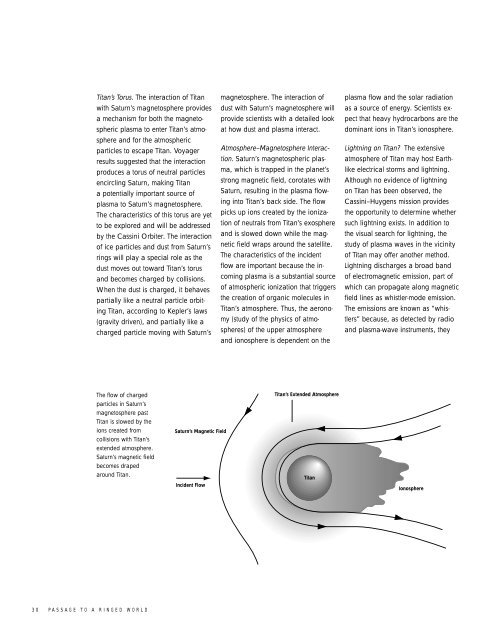Passage to a Ringed World - NASA's History Office
Passage to a Ringed World - NASA's History Office
Passage to a Ringed World - NASA's History Office
Create successful ePaper yourself
Turn your PDF publications into a flip-book with our unique Google optimized e-Paper software.
30 PASSAGE TO A RINGED WORLD<br />
Titan’s Torus. The interaction of Titan<br />
with Saturn’s magne<strong>to</strong>sphere provides<br />
a mechanism for both the magne<strong>to</strong>spheric<br />
plasma <strong>to</strong> enter Titan’s atmosphere<br />
and for the atmospheric<br />
particles <strong>to</strong> escape Titan. Voyager<br />
results suggested that the interaction<br />
produces a <strong>to</strong>rus of neutral particles<br />
encircling Saturn, making Titan<br />
a potentially important source of<br />
plasma <strong>to</strong> Saturn’s magne<strong>to</strong>sphere.<br />
The characteristics of this <strong>to</strong>rus are yet<br />
<strong>to</strong> be explored and will be addressed<br />
by the Cassini Orbiter. The interaction<br />
of ice particles and dust from Saturn’s<br />
rings will play a special role as the<br />
dust moves out <strong>to</strong>ward Titan’s <strong>to</strong>rus<br />
and becomes charged by collisions.<br />
When the dust is charged, it behaves<br />
partially like a neutral particle orbiting<br />
Titan, according <strong>to</strong> Kepler’s laws<br />
(gravity driven), and partially like a<br />
charged particle moving with Saturn’s<br />
The flow of charged<br />
particles in Saturn’s<br />
magne<strong>to</strong>sphere past<br />
Titan is slowed by the<br />
ions created from<br />
collisions with Titan’s<br />
extended atmosphere.<br />
Saturn’s magnetic field<br />
becomes draped<br />
around Titan.<br />
Saturn’s Magnetic Field<br />
Incident Flow<br />
magne<strong>to</strong>sphere. The interaction of<br />
dust with Saturn’s magne<strong>to</strong>sphere will<br />
provide scientists with a detailed look<br />
at how dust and plasma interact.<br />
Atmosphere–Magne<strong>to</strong>sphere Interaction.<br />
Saturn’s magne<strong>to</strong>spheric plasma,<br />
which is trapped in the planet’s<br />
strong magnetic field, corotates with<br />
Saturn, resulting in the plasma flowing<br />
in<strong>to</strong> Titan’s back side. The flow<br />
picks up ions created by the ionization<br />
of neutrals from Titan’s exosphere<br />
and is slowed down while the magnetic<br />
field wraps around the satellite.<br />
The characteristics of the incident<br />
flow are important because the incoming<br />
plasma is a substantial source<br />
of atmospheric ionization that triggers<br />
the creation of organic molecules in<br />
Titan’s atmosphere. Thus, the aeronomy<br />
(study of the physics of atmospheres)<br />
of the upper atmosphere<br />
and ionosphere is dependent on the<br />
Titan’s Extended Atmosphere<br />
Titan<br />
plasma flow and the solar radiation<br />
as a source of energy. Scientists expect<br />
that heavy hydrocarbons are the<br />
dominant ions in Titan’s ionosphere.<br />
Lightning on Titan? The extensive<br />
atmosphere of Titan may host Earthlike<br />
electrical s<strong>to</strong>rms and lightning.<br />
Although no evidence of lightning<br />
on Titan has been observed, the<br />
Cassini–Huygens mission provides<br />
the opportunity <strong>to</strong> determine whether<br />
such lightning exists. In addition <strong>to</strong><br />
the visual search for lightning, the<br />
study of plasma waves in the vicinity<br />
of Titan may offer another method.<br />
Lightning discharges a broad band<br />
of electromagnetic emission, part of<br />
which can propagate along magnetic<br />
field lines as whistler-mode emission.<br />
The emissions are known as “whistlers”<br />
because, as detected by radio<br />
and plasma-wave instruments, they<br />
Ionosphere
















